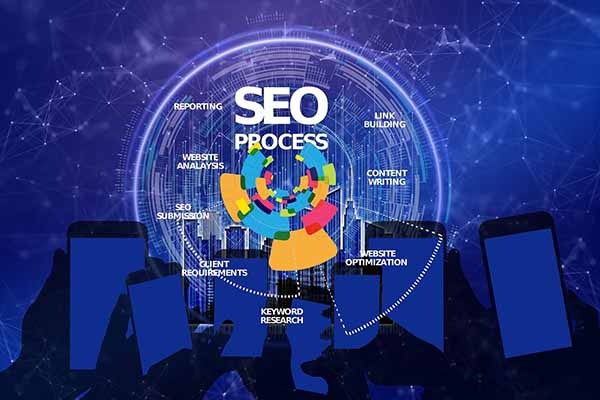On-Page SEO focuses on optimising the content and structure of your website to improve its visibility in search engine results pages (SERPs) and enhance user experience.
1.Optimising for Search Intent:
Understanding user intent is crucial for creating content that resonates with your target audience. For instance, if you run a local bakery, optimising your website for keywords like "best artisanal bread" or "fresh pastries near me" can attract customers seeking specific products or services in their vicinity. "Aligning your content with user intent is the cornerstone of effective SEO. It's not just about ranking high; it's about delivering what users are searching for." - Neil Patel
2. Title Tags, Meta Descriptions, and URLs:
Crafting compelling title tags, meta descriptions, and URLs can significantly impact click-through rates and improve search visibility. According to Backlinko, pages with optimised meta descriptions have a 5.8% higher click-through rate. For example a local landscaping company optimises its meta description with keywords like "professional landscaping services" and "expert garden design," leading to increased clicks and website visits from users searching for these services.
3. Keyword Optimization
Strategic keyword placement throughout your content signals relevance to search engines and improves ranking potential. However, keyword stuffing should be avoided as it can harm user experience and lead to penalties. According to HubSpot, long-tail keywords with lower search volume account for 70% of all web searches, emphasising the importance of targeting niche keywords for specific audience segments.
4. Schema Markup:
Implementing structured data markup enables search engines to understand and display your content more effectively. Websites with schema markup can experience a 30% increase in click-through rates, according to Search Engine Land. For example a small e-commerce store uses schema markup to highlight product prices, ratings, and availability in search results, resulting in higher visibility and click-through rates compared to competitors without markup.
5. Page Speed and Image Optimization:
Page Speed and Image Optimization: Studies show that 40% of users abandon websites that take more than three seconds to load. Optimising page speed and image sizes can significantly improve user experience and reduce bounce rates, leading to higher search rankings. Google has indicated that page speed is a ranking factor for both desktop and mobile searches, underscoring the importance of optimising website performance.
6. Internal Linking:
Establishing a robust internal linking structure helps distribute link equity throughout your site, improves navigation, and enhances user engagement. For example a small law firm strategically interlinks relevant blog posts and service pages, guiding users to explore related topics and services, ultimately leading to longer session durations and increased conversions.
Off-Page SEO: Building Authority and Trust
Off-Page SEO focuses on activities conducted outside your website to establish authority and credibility, thereby improving search engine rankings and attracting organic traffic.
1. External Link Building:
Acquiring backlinks from reputable websites is a critical off-page SEO tactic. Websites with a strong backlink profile tend to rank higher in search results. Backlinko's analysis found a strong correlation between the number of referring domains and higher search rankings, emphasising the importance of quality backlinks.
2. Content Marketing:
Producing high-quality, valuable content attracts natural backlinks and enhances brand visibility, ultimately driving more traffic to your website. "Content is the atomic particle of all digital marketing. Every social media post, every email, every landing page, and every ad is content." - Rebecca Lieb Digital content and SEO consultant
3. Local SEO:
Optimising your online presence for local search is essential for small businesses targeting geographically specific audiences. According to Google, 46% of all Google searches have local intent. Optimising your website for local SEO factors like Google My Business listings and local citations can significantly improve your visibility in local search results.
4. Social Media Engagement:
Actively engaging with your audience on social media platforms amplifies brand awareness, drives traffic to your website, and signals social relevance to search engines. According to Statista, there are over 4.2 billion active social media users worldwide, highlighting the immense potential for small businesses to connect with their target audience on social platforms.
5. Public Relations and Brand Building:
Establishing positive relationships with media outlets and building a strong brand reputation contribute to increased visibility and trustworthiness. "Your brand is what other people say about you when you're not in the room." - Jeff Bezos - Amazon
6. Guest Posting:
Publishing guest posts on reputable websites expands your reach, establishes credibility, and generates valuable backlinks to your site. For example a small marketing agency contributes guest posts to industry-leading publications, positioning itself as a thought leader in the marketing space and attracting high-quality backlinks from authoritative sources.
Technical SEO: Optimising Behind the Scenes
Technical SEO involves optimising the technical aspects of your website to improve its crawling, indexing, and overall performance.
1. JavaScript Optimization:
Ensuring that JavaScript elements are crawlable and render properly improves website accessibility and search engine visibility. For example an e-commerce website uses server-side rendering (SSR) to ensure that JavaScript-generated content is fully rendered and accessible to search engine crawlers, leading to improved indexation and ranking.
2. XML Sitemaps
Creating XML sitemaps helps search engines understand the structure of your website and prioritise crawling of important pages. According to Google, websites with XML sitemaps are crawled more efficiently, resulting in faster discovery of new and updated content.
3. Site Architecture and URL Structure:
Establishing a logical site architecture and URL structure enhances user experience and facilitates crawling and indexing by search engines. A small business reorganises its website structure to create a clear hierarchy of categories and subcategories, making it easier for users and search engines to navigate.
4. Structured Data:
mplementing structured data markup enables search engines to better understand and display your content in rich snippets and other enhanced search features. Websites with structured data markup can experience a 30% increase in click-through rates, according to Search Engine Land.
5. Thin and Duplicate Content Management:
Removing or consolidating thin and duplicate content prevents dilution of keyword relevance and improves overall site quality. "Quality content is the key to success in SEO. Thin and duplicate content can harm your website's visibility and credibility in the eyes of search engines and users alike." - Rand Fishkin formerly of MOZ.
6. Hreflang Tags, Canonical Tags, and Redirects:
mplementing hreflang tags, canonical tags, and proper redirect management ensures that users are directed to the correct version of your content, improving user experience and avoiding duplicate content issues. For example an e-commerce website uses hreflang tags to serve different language versions of its content to users in different regions, ensuring a localised and relevant experience.


